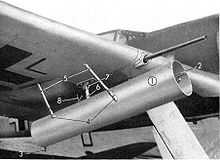Werfer-Granate 21

The Werfer-Granate 21 rocket launcher, also known as the BR 21 (the "BR" standing for Bordrakete) in official Luftwaffe manuals, was a weapon used by the German Luftwaffe during World War II and was the first on-board rocket placed into service by the Luftwaffe, first introduced in mid 1943. The weapon was developed by Rheinmetall-Borsig under the leadership of Dipl.-Ing. Rudolf Nebel, who had pioneered German use of wing-mounted offensive rocketry in World War I with the Luftstreitkräfte.
History
The tight formations flown by USAAF heavy bombers allowed their defensive heavy machine guns to provide mutual cover to one another, and such a combat box was an extremely dangerous environment for a fighter aircraft to fly through, with dozens of heavy machine guns aimed at attacking Luftwaffe fighters from almost every conceivable direction. This weapon enabled the German pilots to attack their bomber targets from a safer distance of over a kilometer, where the risk of being hit was much reduced. Although extremely inaccurate, the rockets did not have to destroy the bombers, but only cause them to take evasive action that would disrupt their protective formation, making them vulnerable to conventional attack. While a single fighter's payload of two or four such rockets was extremely unlikely to score a hit, a mass launch by an entire fighter squadron (12-16 aircraft) as it arrived to intercept the bombers would likely score two or three hits, about 15% accuracy. The rocket's huge blast radius also compensated for inaccuracy, and even a non-lethal hit on a bomber by a showering of shrapnel would have psychological effects and perhaps cause it to take evasive manœuvres that would drive it from the protection of its fellows.
JG 1 and JG 11 were the first front line units to utilise the weapon during the spring of 1943. During the autumn of 1943 the Bf 110 G-2 Zerstörer of ZG 26 and ZG 76 were also equipped with it.
These weapons were also sometimes used against ground targets from late 1943 onwards, such as in the Italian campaign 1943–44, the 1944 Normandy campaign and during the Ardennes Offensive.
Design and capabilities

Modified from the 21 cm Nebelwerfer 42 infantry barrage rocket projectile and reconfigured for air-launch, the spin-stabilised rocket was propelled by 18.4 kilograms (41 lb) diglycol solid fuel, and the warhead weighed 40.8 kilograms (90 lb). The Wfr. Gr. 21's projectile had a velocity of 320 metres (350 yd) per second (1,150 km/h, 716 mph) and a maximum range of 1,200 metres (1,300 yd). The rocket and tube weighed some 112 kilograms (247 lb) in total. A time fuse detonated the warhead at a pre-set distance of 600 metres (2,000 ft) to 1,200 metres (3,900 ft) from launch point, resulting in a lethal blast area approximately 30 metres (98 ft) wide.
Usage
Single seat fighters carried a single tubed rocket under each wing, while the Zerstörer heavy twin engine fighters carried two under each wing. Operationally the weapon had several disadvantages; the launcher tubes produced significant air resistance and reduced speed and manoeuvrability and general performance. The tubes were jettisonable, and once the rocket had been fired the fighter could revert to a 'clean' profile.
Shortcomings
The relatively low velocity of the rocket created a considerable problem in attempting to counter the resultant ballistic drop of such a slow-moving projectile, which required that the launcher tubes be mounted at a roughly 15° angle upwards from the line of flight, causing considerable drag on the airframe of the carrier aircraft. The low launch velocity also meant accurate aiming was difficult, as it was for the attacking pilot to accurately judge the distance to the target. As a result most of the rockets fired exploded either in front of or behind the bomber target. However, they did often achieve the effect of opening up the bomber formations enough for fighters to attack with conventional weapons.
Aircraft armed with the Wfr. Gr. 21
Underwing mount (singly, one under each wing)
- Focke-Wulf Fw 190 A-7 and newer: as Rüstsatz 6 (/R6) modification
- Messerschmitt Bf 109G: as BR21 modification
Underwing mount (two under each wing)
Under-fuselage mount (one each side, from bomb racks flanking nosegear well)
External links
- http://www.adlertag.de/waffen/rockets.htm
- (German) http://www.luftarchiv.de/index.htm?/flugkorper/wgr21.htm